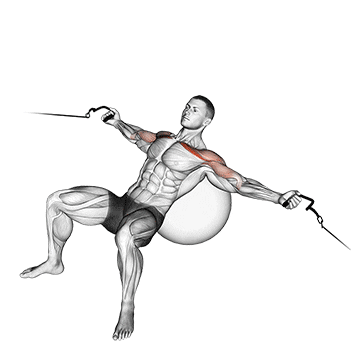The Cable Incline Fly is a challenging variation of the traditional incline fly exercise performed on a stability ball. This exercise targets the chest muscles, particularly the upper chest, and helps improve strength and definition in the chest area.
How to perform
To perform the Cable Incline Fly on a stability ball, follow these step-by-step instructions:1. Set up a cable machine with the handles at the lowest position and attach a D-handle to each side of the machine.
2. Place a stability ball in front of the cable machine and sit on the ball with your feet planted firmly on the ground.
3. Grab the handles with an overhand grip, palms facing forward, and walk your feet forward to create tension in the cables.
4. Slowly walk your feet forward until your head and shoulders are resting comfortably on the stability ball, keeping your hips lifted and core engaged.
5. With a slight bend in your elbows, exhale and simultaneously bring the handles together in front of your chest, squeezing your chest muscles at the top of the movement.
6. Inhale and slowly return the handles back to the starting position, maintaining control throughout the movement.
7. Repeat for the desired number of repetitions.
Tip: Keep your chest up, shoulders back, and core engaged throughout the exercise to maintain stability on the stability ball.
Note: It is important to use a weight that challenges you but still allows you to maintain proper form throughout the exercise. Consult a fitness professional before attempting this exercise if you are unsure about your form or technique.
Equipment required
Cable
Cable equipment consists of adjustable pulleys attached to weight stacks that allow for resistance training. This equipment is commonly used for strength training exercises that target various muscle groups in the body, such as chest, back, arms, and legs. Cable equipment provides a versatile and functional way to perform exercises that mimic real-life movements, improving muscle endurance, stability, and coordination.
Stability Ball
Stability balls are large, inflatable balls commonly used in fitness and physical therapy. They are utilized to improve core strength, balance, flexibility, and overall stability. These balls are versatile equipment that can be used for various exercises like core workouts, balance training, strength training, and stretching. Using a stability ball can enhance muscle performance and improve posture, making it an effective tool for both exercise enthusiasts and individuals in rehabilitation.


